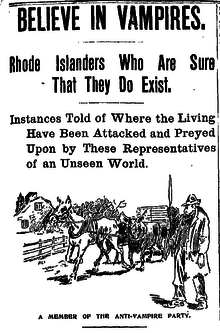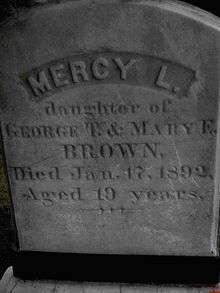New England vampire panic
The New England vampire panic was the reaction to an outbreak of tuberculosis in the 19th century throughout Rhode Island, eastern Connecticut, Vermont, and other parts of New England.[1] Consumption (tuberculosis) was thought to be caused by the deceased consuming the life of their surviving relatives.[2] Bodies were exhumed and internal organs ritually burned to stop the "vampire" from attacking the local population and to prevent the spread of the disease. Notable cases provoked national attention and comment, such as those of Mercy Brown in Rhode Island and Frederick Ransom in Vermont.

Background
Tuberculosis was known as "consumption" at the time, as it appeared to consume an infected person's body.[3] It is now known to be a bacterial disease, but the cause was unknown until the late 19th century.[4] The infection spreads easily among a family; thus, when one family member died of consumption, other members were often infected and gradually lost their health. People believed that this was due to the deceased TB sufferer draining the life from other family members.[2] The belief that consumption was spread in this way was widely held in New England[5]:214 and in Europe.[6]
In an attempt to protect the survivors and ward off the effects of consumption, bodies of those who had died of the disease were exhumed and examined. The corpse was deemed to be feeding on the living if it was determined to be unusually fresh, especially if the heart or other organs contained liquid blood. After the culprit was identified, there were a number of proposed ways to stop the attacks. The most benign of these was simply to turn the body over in its grave. In other cases, families would burn the "fresh" organs and rebury the body; occasionally, the body would be decapitated. Affected family members would also inhale smoke from the burned organs or consume the ashes in a further attempt to cure the consumption.[7]:130
Documented victims
| Date of exhumation | Name and lifespan | Location of exhumation | Notes |
|---|---|---|---|
| 1793 | Rachel (Harris) Burton (1770–1790) | Manchester, Bennington County, Vermont | Congregational Deacon Capt. Isaac Burton exhumed his first wife, Rachel, in an attempt to save his second wife Hulda (Powell) Burton who was dying of tuberculosis. The effort failed and Hulda died in September 1793.[8] |
| ca 1810 | Unnamed New Ipswich resident | New Ipswich, Hillsborough County, New Hampshire | Dr. John Clough of New Ipswich, N.H. reported in "The Influence of the Mind on Physical Organization" in the Boston Medical and Surgical Journal Volume XXI (1840): "In connection with [these superstitions], I cannot omit to mention a circumstance which occurred in this town (New Ipswich), not thirty years since, and similar occurences probably occurred in many other towns in New England. This was disinterring a human body, which belonged to a family all strongly predisposed to consumption, for the purpose of removing the heart, which was burned, the ashes of which were considered a sovereign remedy to those of the family who were still living, and might be afflicted with the same disease. This only illustrates the fact that those elements of character which held such a magic sway over the minds of men in ancient times, have not ceased altogether to influence the community in our comparitively enlightened day."[9] |
| 1816–1817 | Samuel Salladay (1789–1815) | Scioto County, Ohio | "A STRANGE SUPERSTITION. The family of Philip Salladay came from Switzerland, bought and settled on a lot in the French Grant soon after the opening of the country for settlement. Hereditary consumption developed itself in the family sometime after their location in Scioto county. The head of the family and the oldest son had died of it and others began to manifest symptoms, when an attempt was made to arrest the progress of the disease by a process which has been practised in numerous instances, but without success. They resolved to disinter one of the victims, take his entrails and burn them in a fire prepared for the purpose, in the presence of the surviving members of the family. This was accordingly done in the winter of 1816–17, in the presence of a large concourse of spectators who lived in the surrounding neighborhood, and by Major Amos Wheeler, of Wheelersburg. Samuel Salladay was the one they disinterred and offered up as a sacrifice, to stop if possible the further spread of the disease. But like other superstitious notions with regard to curing diseases it proved of no avail. The other members of the family continued to die off until the last one was gone except George."[10] |
| 1817 | Frederick Ransom (1797–1817) | South Woodstock, Windsor County, Vermont | |
| ca 1860s | Anonymous sibling | Boston, Suffolk County, Massachusetts | In 1873, Dr. Lucy Abell reported to the Massachusetts State Board of Health: "I should be sorry to be understood as recommending drunkenness as a cure [for consumption]. But I have known several instances where nearly all the family from five to nine children have successively died of phthisis. Finally one of the boys from sheer desperation took to excessive drinking of alcoholic stimulants. These boys are now past middle life and enjoying good health when last heard from. In two families not less than five or six victims in each were carried off by consumption. In each there was always one sick and a short time before death another would be prostrated. In one family they resorted to that horrible relic of superstition the burning of the heart etc. of the dead and the ashes were swallowed by the survivors in the hopes that the fatal demon would be exorcised from the family, but it did not avail. But another son fell a victim and then the alcoholic treatment was tried not as an expected remedy but as a means of forgetfulness of impending doom and no deaths in the family have to my knowledge since occurred."[11] |
| 1892 | Mercy Lena Brown (1872–1892) | Exeter, Washington County, Rhode Island | Mercy Brown vampire incident |
Mercy Brown

One of the more famous cases is that of Mercy Lena Brown. Mercy's mother contracted consumption which spread to the rest of the family, moving to her sister, her brother, and finally to Mercy. Neighbors believed that one of the family members was a vampire who had the illness. Two months after Mercy's death, her father George Brown—who did not believe that a vampire was to blame—reluctantly permitted others to exhume the bodies of his family. They found that Mercy's body showed little decomposition, had "fresh" blood in her heart, and had turned in the grave.[12] This was enough to convince the villagers that Mercy Brown was the cause of the consumption. The heart of the exhumed body was burnt, mixed with water, and given to her surviving brother to drink in order to stop the influence of the undead. Unsurprisingly, the cure was unsuccessful.[1]
Frederick Ransom
Frederick Ransom of South Woodstock, Vermont died of tuberculosis on 14 February 1817 at the age of 20.[5]:238 His father was worried that Ransom would attack his family, so he had him exhumed and his heart burned on a blacksmith's forge.[13] Ransom was a Dartmouth College student from a well-to-do family; it was unusual that he should fall victim of the vampire panic, which was most common among less educated communities.[14]
Contemporary reaction
Henry David Thoreau wrote in his journal of 26 September 1859: "The savage in man is never quite eradicated. I have just read of a family in Vermont—who, several of its members having died of consumption, just burned the lungs & heart & liver of the last deceased, in order to prevent any more from having it," as a reference to contemporary superstition.[15] When rural Rhode Islanders moved west into Connecticut, locals perceived them as "uneducated" and "vicious", which was partially due to the Rhode Islanders' beliefs in vampirism.[2] Newspapers were also sceptical, calling belief in vampirism an "old superstition" and a "curious idea".[7]:132
While the press dismissed this practise as superstition, the burning of organs was widely accepted as a folk medicine in other communities. In Woodstock, where local belief was still present, town records report hundreds of onlookers attending the burning of Frederick Ransom's heart."[1]
Terminology
It is unlikely that the deceased would have been known as vampires by their affected families, because the word was not in common use in the community at that time. However, the term was used by newspapers and outsiders at the time due to the similarity with contemporary vampire beliefs in eastern Europe.[12]
These beliefs were very different from the vampires portrayed in modern popular culture. Michael Bell conducted an anthropological study of the phenomenon in New England, and he rejected that modern narrative: "No credible account describes a corpse actually leaving the grave to suck blood, and there is little evidence to suggest that those involved in the practice referred to it as 'vampirism' or to the suspected corpse as a 'vampire', although newspaper accounts used this term to refer to the practice."[7]
See also
References
- Tucker, Abigail. "The Great New England Vampire Panic". Smithsonian magazine (October 2012). Retrieved 2012-12-02.
- Sledzik, Paul S.; Nicholas Bellantoni (1994). "Bioarcheological and biocultural evidence for the New England vampire folk belief" (PDF). American Journal of Physical Anthropology. 94 (2): 269–274. doi:10.1002/ajpa.1330940210. PMID 8085617. Archived from the original (PDF) on 2003-10-04.
- "Learn the Signs and Symptoms of TB Disease" Centers for Disease Control and Prevention. 18 June 2012. Web. 2 December 2012.
- Madigan, Michael T., et al. Brock Biology of Microorganisms: Thirteenth edition. Benjamin Cummings: Boston, 2012. Print.
- Guiley, Rosemary (2005). The Encyclopedia of Vampires, Werewolves, and Other Monsters. Facts on File. ISBN 978-0-8160-4684-3.
- Ingber, Sasha (2012-12-17). "The Bloody Truth About Serbia's Vampire". National Geographic News. Archived from the original on 20 December 2012. Retrieved 15 August 2013.
- Bell, Michael (2006). "Vampires and Death in New England, 1784 to 1892". Anthropology and Humanism. 31 (2): 124–140. doi:10.1525/ahu.2006.31.2.124.
- D’Agostino, Thomas (October 13, 2014). "The Vampire of Manchester, Vermont".
- "Boston Medical and Surgical Journal". 1840.
- Howe, Henry (1891). Historical Collections of Ohio: In Three Volumes; An Encyclopedia of the State, Volume 3. Columbus, Ohio: Henry Howe & Son. p. 243.
- Fourth Annual Report of the State Board of Health of Massachusetts, January 1873. Boston, Massachusetts: Wright & Potter. 1873. pp. 338–339.
- "Interview with a REAL Vampire Stalker". SeacoastNH.com. Retrieved 2013-08-15.
- Henderson, Gareth (18 November 2010). "'History of Vampires' Recounts Woodstock Tale". Vermont Standard. Retrieved 2013-08-16.
- Tucker, Abigail. "Meet the Real-Life Vampires of New England and Abroad". Smithsonian magazine (September 2012). Retrieved 2013-08-15.
- Thoreau, Henry David, Bradford Torrey, and Francis H. Allen. "Journal." Journal. Vol. 30. New York: Dover Publications, 1962. N. pag. Print. Manuscript.